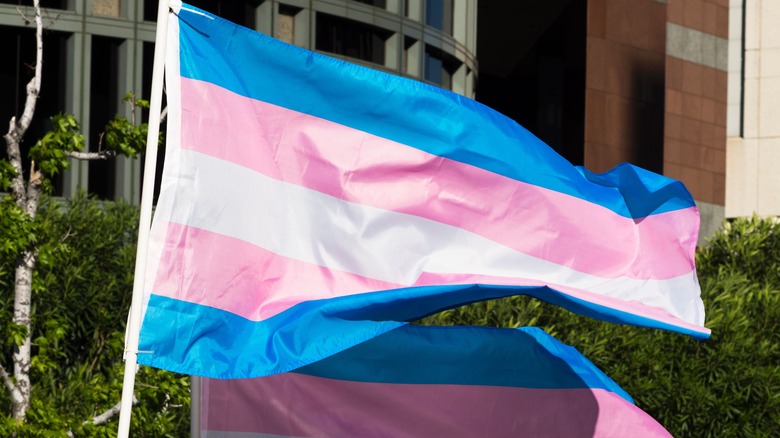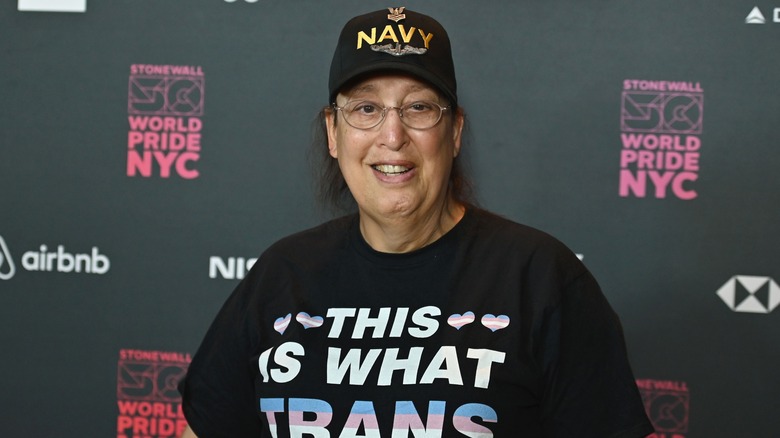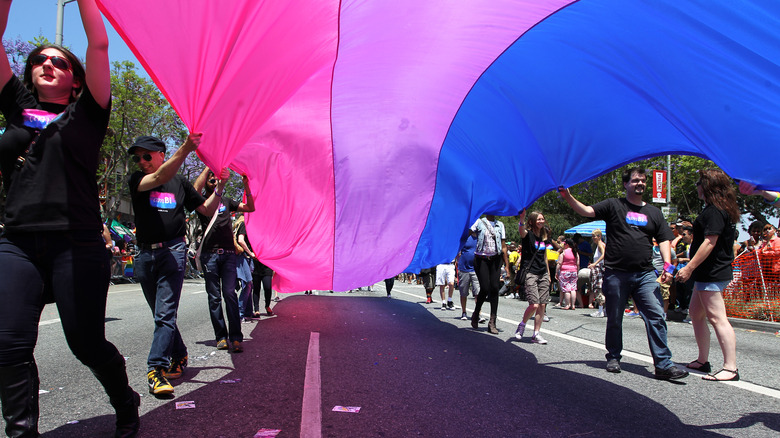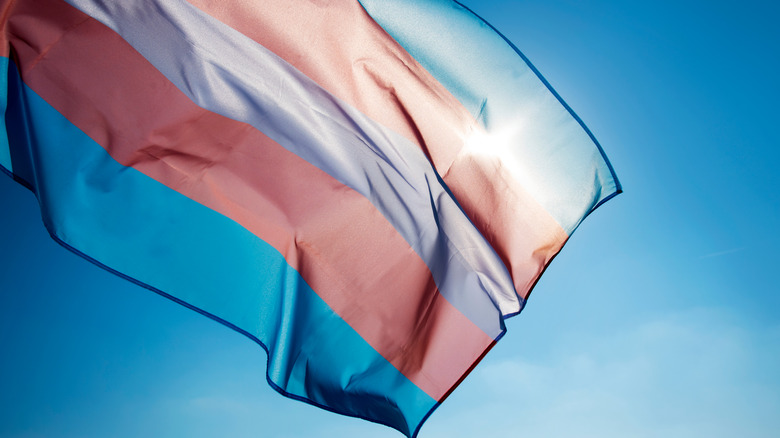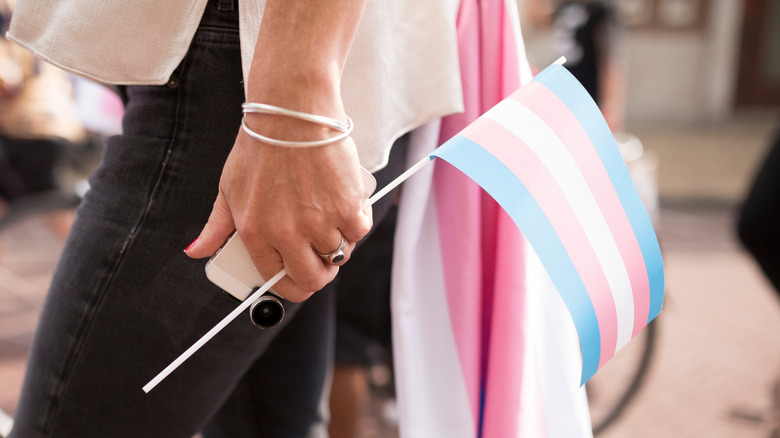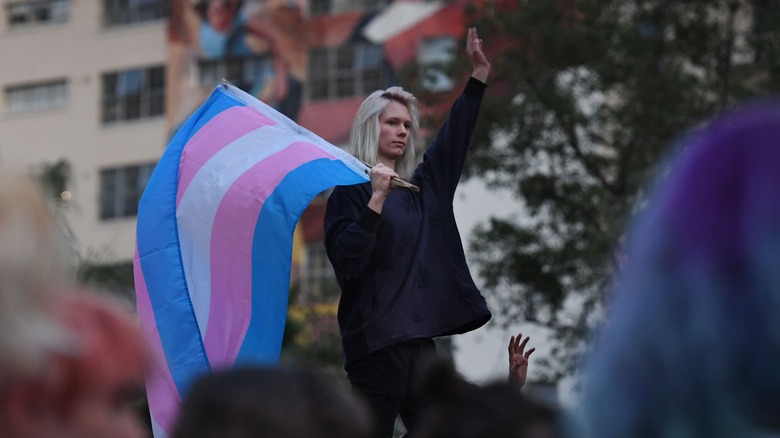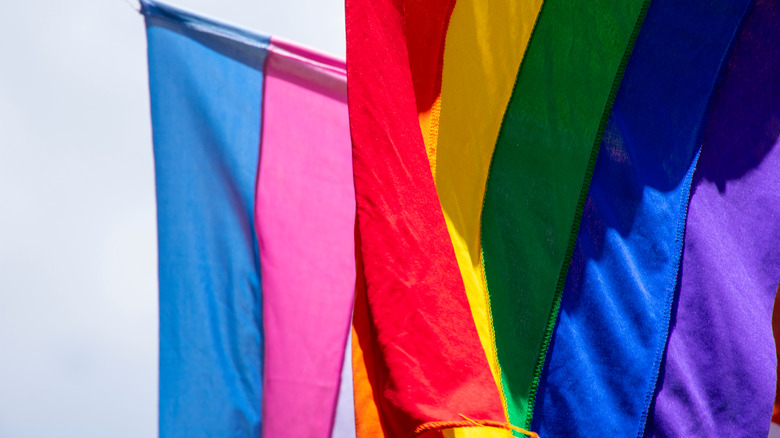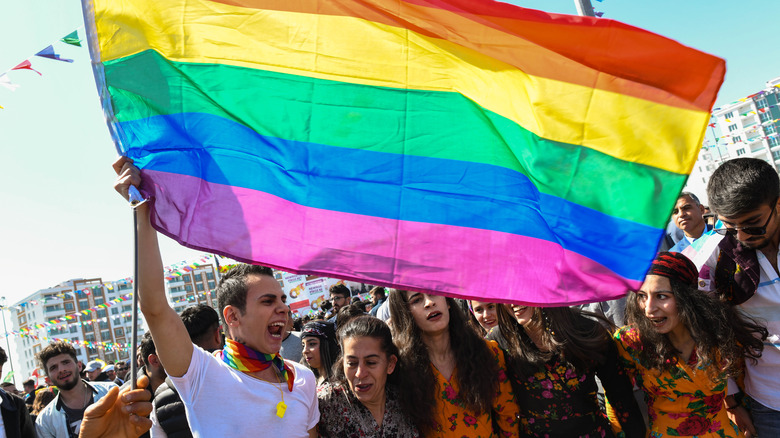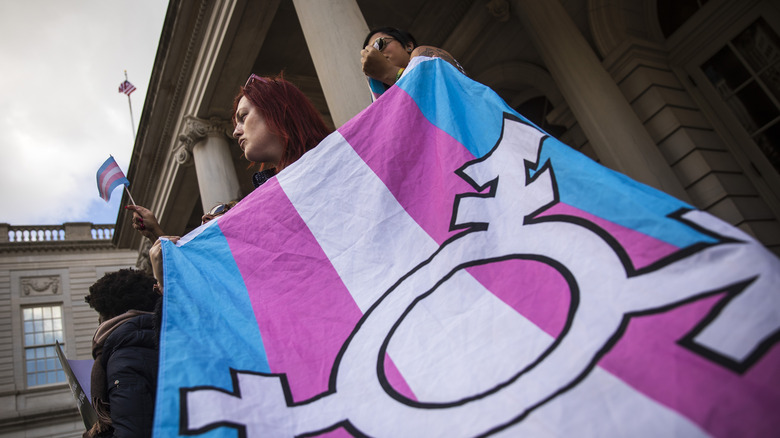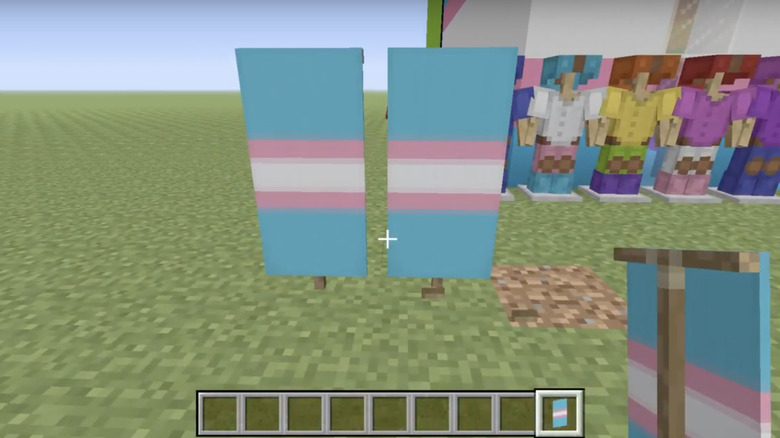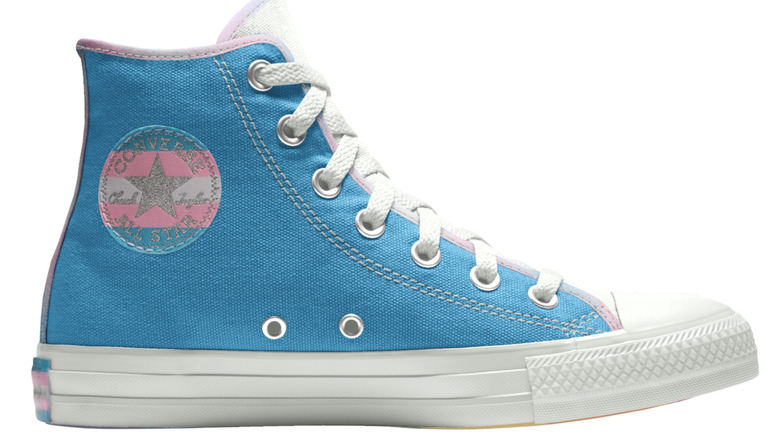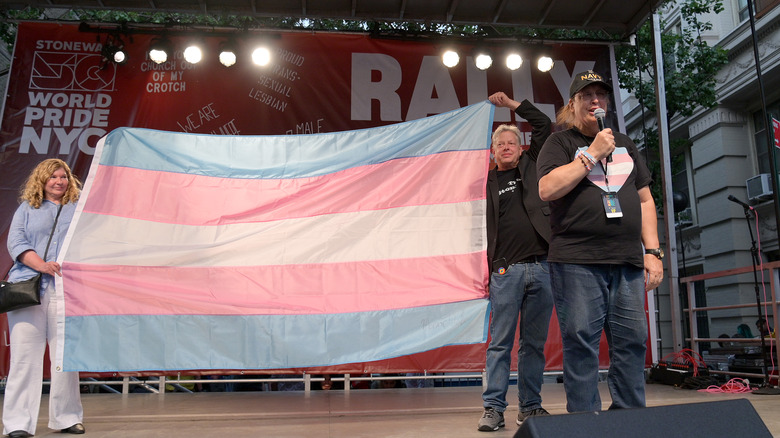The Truth About The Trans Flag
We may receive a commission on purchases made from links.
Transgender visibility has increased dramatically over the years, according to an article in Forbes, and we couldn't be happier about it. Seeing people live their best and most authentic lives is empowering for everyone, and it's super important that everyone gets to live comfortably in their own skin.
Interestingly enough, one of the most visible trans icons isn't a person like Laverne Cox or Chaz Bono, but is actually an object: the trans flag. You're bound to see it at every pride march in a variety of forms and sometimes flying atop the flagpole at municipal centers, showing just how much transgender rights have become central in our society.
So where did the iconic pink, blue, and white flag come from? Was it designed around a conference table at GLAAD or HRC, or was it the brainchild of a flag manufacturer? And what do the colors on the flag represent? Read on to discover the truth about the trans pride flag.
Meet Monica Helms, the trans flag's designer
Believe it or not, the trans flag wasn't conceived of by Big Flag. Rather, it was brought into the world by Monica Helms, a longtime transgender activist and herself a transgender woman, earning her the moniker of the "transgender Betsy Ross." It's certainly an appropriate nickname given that Betsy Ross is credited with creating the design of the American flag.
In addition to designing the trans flag, Helms has an impressive career fighting for transgender rights, according to her biography on Amazon. A Navy veteran, she founded the Transgender American Veterans Association in 2003, and she served as its president for a decade. She also lobbied state legislators in both Arizona and Georgia, and, in 2004, Helms attended the Democratic National Convention as a delegate. Those are some impressive credentials, for sure.
Helms also penned an autobiography that published in March of 2019 entitled More Than Just a Flag, and she was a grand marshal at the 2019 World Pride Festival in New York City. Respect!
Divine intervention inspired the trans flag
Monica Helms' idea to design a transgender flag came about in a 1999 discussion she had with her friend Michael Page, who had just designed the bisexual pride flag the previous year. "He and I were talking and he said, 'You know, the trans community could use a flag,'" she recalled in an interview with Gay City News. "I couldn't come up with anything. He said to keep it simple because the least amount of stitches, the cheaper it is to make." That's definitely a practical approach.
But that lack of inspiration didn't last for long. As Helms tells it, she had an epiphany one morning just after waking up, which she's referred to as "divine intervention." "When you wake up and you're still sort of groggy and everything but you're starting to think and your mind is starting to fill with images — that's when it came to me," she revealed in an interview with The Daily Beast. Sounds like it just took a little bit of magic to manifest her now-iconic vision.
The colors of the trans flag have a specific meaning
The very nature of flags is to symbolize a country or concept, so everything on them is significant in some way. For example, the stars on the U.S. flag represent the 50 states, the stripes represent the original 13 colonies, and the colors represent characteristics that the U.S. finds morally important, according to PBS.
Of course, the colors on the trans flag are significant as well, according to Monica Helms. "The stripes at the top and bottom are light blue, the traditional color for baby boys," she explained in an article in Point 5CC. "The stripes next to them are pink, the traditional color for baby girls. The stripe in the middle is white, for those who are intersex, transitioning or consider themselves having a neutral or undefined gender." So that's what the colors represent!
Additionally, the flag's design is strategic, in that the flag is the same upside-down as it is right-side up. "The pattern is such that no matter which way you fly it, it is always correct, signifying us finding correctness in our lives," she continued. That's some super poignant symbolism.
The trans flag first appeared at a march in 2000
After Monica Helms' episode of "divine intervention," she got to work right away. First, she sketched out her design on paper, totally pleased with how it had manifested. Next, she contacted the same company that her friend Michael Page used to make the bisexual pride flag, and had them send her some fabric swatches, as covered by a video Helms posted on YouTube. Then, two weeks after she selected the colors that were to be used, the very first trans flag was sent to her by the company. It was happening, you guys!
Once the flag was in Helms' hands, she was interviewed about it for a local publication. After that, she was ready to bring the flag out into the world for everyone to see. In April 2000, Helms "took the flag to the Phoenix pride, and marched in the color guard," as her YouTube video noted. After that, she brought the flag to subsequent events, and it started getting more and more popular. Eventually it was adopted by the LGBTQ+ community. Thus a legend was born!
The trans flag creator didn't intend to create a worldwide icon
When Monica Helms made her trans flag, she had no idea that it would become the celebrated banner that it is today. "I never set out to create a worldwide icon, but that is something it has become," she confessed in an interview with Queerty. "I just wanted a symbol, something that I felt reflected my pride in being transgender, something that might help bring [our] community together or unite us." Those are really wholesome intentions, and it's pretty epic that the flag is so insanely popular now.
Additionally, the trans pride flag transcends age, race, gender, and ethnicity, something that Helms treasures. "It humbles me to see the flag carried by others in the world," she continued. "Over the years people have told me what it means to them and it fills me with pride. I hope it continues to make others proud as well." Given how many people wave the flag with great gusto, we know that it will.
The trans flag even flew over Antarctica
In 2016, Aaron Jackson, the founder and president of the non-profit organization Planting Peace, set out on a mission. His goal? To travel the continent of Antarctica with both a gay pride flag and a trans pride flag, thereby declaring Antarctica LGBTQ+ friendly. "I traveled to Antarctica to play a role in spreading visibility for the need for basic human rights for the LGBT community," he explained in an interview with HuffPost.
Monica Helms was both overjoyed and overwhelmed when she saw that the trans pride flag had flown on the continent. "Seeing a picture of someone opening it up on Antarctica was a huge moment for me," she revealed in an interview with Queerty. Can you imagine how that had to feel?
There's one more place that Helms hopes to see the flag fly: the International Space Station. "I've always been a Sci-Fi fan, I've loved space since I was a child, and have launched model rockets my entire life," she continued. "So, if I had one last wish for the flag, it would be that." Hey, NASA — can you make this happen?
The trans flag didn't make Helms rich
Oftentimes, when people create something unique, they'll make sure to put a copyright on it so that other people can't use their work without paying for it. That also helps creators maintain control over their creations, as they can dictate how their original work is used and copied by other people.
But Monica Helms didn't design the trans pride flag in order to get rich, so she never put a copyright on it. Like the gay pride flag designed by Gilbert Baker in 1978, the transgender flag belongs to the entire LGBTQ+ community — and Helms is just fine with that. "This was for me and if nobody had embraced it, it still would have been OK for me," she explained in an interview with The Daily Beast. "But then people started seeing it and they thought the pattern was great and they liked the reason for the colors and it just took off." That it did!
Still, Helms does call the transgender pride flag her "baby," and we're 100 percent okay with that. She did bring it into the world, after all.
Some people think the pride flag is already enough
For the most part, the trans flag has been received with open arms and open hearts by LGBTQ+ people. But there are some individuals in the community who are critical of the flag, as they believe the traditional gay pride flag adequately represents everyone. Well, you can't please everyone, as the old adage goes.
Of course, if Monica Helms agreed with that, she never would have created the transgender flag to begin with — but she specifically wanted a banner that was unique to transgender people. "I say the rainbow flag is like the American flag: everybody's underneath that," she shared in an interview with The Daily Beast. "But each group, like each state, has their own individual flag." Indeed, there's the bisexual flag, the intersex flag, and so on.
The transgender pride flag is obviously here to stay, so any haters just have to get used to it.
There are alternate versions of the trans flag
While Monica Helms' version of the trans flag is the widely accepted numero uno, that doesn't mean it's the only version of the trans pride flag out there. That's not surprising, given that Helms came up with her design on her own, so surely other people had similar experiences.
To that end, there are two specific flags that serve as alternatives to Helms' baby. The first flag was created by a Canadian designer named Michelle Lindsay, which is half pink and half blue and has a white trans symbol in the middle, as explained by Point 5CC. It was first flown in 2010 at the Ottawa area Transgender Day of Remembrance, and it continues to be used in the region.
The second alternate flag is bright green and features a black trans symbol in the center. This version was created by the genderqueer and transgender community in Israel, which is where it's used the most. The more you know!
The original trans flag is in a museum
After her original trans flag's many years of honorable service, Monica Helms decided that it was time to retire it from active duty. So she contacted the Smithsonian, hoping that they would be interested in giving it a permanent home — and they were! They also wanted some of the artifacts from her service in the Navy, according to the National Center for Transgender Equality (NCTE). What an honor.
Helms was joined at the ceremony by Mara Keisling, the executive director of the NCTE. "I'm deeply honored that today, the transgender pride flag — our flag — is being accepted as an American historical treasure that honors transgender people," Keisling said at the event. "Today's ceremony is part of the forward cultural change that says — in the eyes of America — transgender people are here, have been here, and will always be here." Louder again for the people in the back!
While Helms was sad to let go of her baby, she's happy to know that it's enshrined forever in American culture. "Our symbol is part of Americana," she proclaimed in an interview with The Daily Beast. "It's treated as that."
This is why you're seeing the trans flag in Minecraft
If you or your child is a fan of Minecraft, you may have noticed that the trans flag (not to mention other pride flags) has been popping up within the game. The reason for that, according to a thread on Reddit, is because the creator of Minecraft — Markus Alexej Persson, or Notch, as he's known — has made transphobic and anti-LGBTQ+ comments more than once (via Variety). Yikes!
Rather than let Notch's comments stand without protest, users decided to push back by bringing their pride to the Minecraft universe. "In light of recent events I'm making LGBT+ Flags in Minecraft!!!" one Reddit user wrote. "I'm gonna make a giant gay flag on my favourite minecraft server now — if they don't know I'm gay yet this will [reveal that] soon!" said another. You guys, we are here for this.
Hopefully, Notch will see the error of his ways and walk back those comments. But until then, everyone's Minecraft games will be a little prouder than usual.
You can even wear the trans flag on your body!
As LGBTQ+ people have become both more visible and more accepted in American society, corporations have taken notice. That's why you can find a whole line of pride apparel at Target and why Bank of America had a float at the pride parade. Given that it was only in 1969 when riots erupted at Stonewall, spearheaded by transgender women of color (via USA Today), it's a surprising development for many.
But it's obviously not a bad thing that corporations have gotten on board with pride month and are catering to LGBTQ+ customers, though one does have to question corporations' true intent. In fact, it's so commonplace now that you can get your hands on some adorable Converse sneakers tricked out in the colors of the trans flag. You guys, these are so cute!
In 2019, Converse offered four different pairs of sneakers for those desiring shoes that match the trans pride flag, according to Gay Star News. Who said you couldn't be comfortable, fashionable, and proud at the same time?
Here's how to get the trans flag in emoji form
You know something has been fully assimilated into our culture when there's an emoji for it. And while Apple hasn't added the trans flag to its emoji keyboard yet, you can still create an emoji of it in WhatsApp for Android, according to an article in Emojipedia. It's finally happening!
So how can you create your very own tiny, digital trans pride flag? In WhatsApp for Android, type in the following sequence: white flag emoji, plus male with stroke emoji, plus male and female sign. When you paste these characters into the app, boom! The transgender pride flag appears. How cool is that?
Hopefully, the trans flag emoji will be added into all platforms sooner rather than later, as it consistently ranks in the top 50 requests for emojis at Emojipedia. We'll definitely be keeping our eyes peeled next time they roll out a new set, for sure.
The trans flag creator has strong feelings about Trump
In an exceedingly controversial move, President Donald Trump issued a ban on transgender people serving openly in the U.S. military, as covered by PBS. Unsurprisingly, when BuzzFeed News asked Monica Helms about it, she had some strong words to share. "What Trump did was strictly to serve his bigot followers and nothing else," the trans flag creator shared. "Trans people have proven to serve well and without any issues, both in our country and several throughout the world." Given that Helms is a proud Navy veteran, you can imagine that this move cut especially deep for her.
But Helms has hope that once the Trump administration leaves the White House, things will be different. "Everything they could find to discriminate against trans people, they've done it," she explained in an interview with the Gay City News. "So I'm just waiting for the next election so we can vote him out of office and get back all the things that we lost." She added that transgender people will continue to exist and won't be erased. We see you, Monica!
